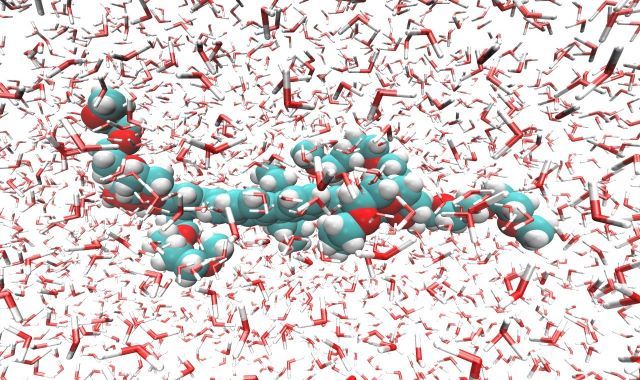ACADEMIA
Alternative method reduces supercomputer simulation time for the absorption spectrum from days to hours

The absorption of light by molecules has various applications in microscopy, medicine, and data storage. A Brazilian physicist has proposed an alternative method that reduces the time required for supercomputer simulation of the absorption spectrum from two days to a few hours. The most suitable method for predicting the one- and two-photon absorption spectra of large molecules in solution is the semi-empirical method INDO/S. This method enables the development of novel compounds with greater efficiency.
Absorption spectroscopy is an analytical chemistry tool that can determine the presence of a particular substance in a sample by measuring the intensity of the light absorbed as a function of wavelength. Measuring the absorbance of an atom or molecule can provide important information about electronic structure, quantum state, sample concentration, phase changes, or composition changes. It can also help determine the interaction of molecules with each other, and their potential technological applications.
Molecules that have a high probability of simultaneously absorbing two photons of low-energy light are highly useful in various fields. They can be used as molecular probes for high-resolution microscopy, as a substrate for data storage in dense three-dimensional structures, or as vectors in medicinal treatments.
Direct experimentation to study the phenomenon can be challenging, and computer simulation is often used alongside spectroscopic characterization. Simulations provide a microscopic view that is difficult to obtain in experiments. However, simulating relatively large molecules can take several days of processing by supercomputers or even months by conventional computers. To address this issue, physicist Tárcius Nascimento Ramos and his team have proposed an alternative calculation method in an article published in The Journal of Chemical Physics.
Ramos explains that they evaluated the performance of a semi-empirical method that was widely used in past decades but has been neglected in recent years because of its approximative nature. Using this method, they were able to reduce the calculation time to just four hours on a conventional computer. This low computing cost allowed them to consider a large statistical sample for simulations of molecules in solutions, which isn't feasible with the currently dominant method - density functional theory (DFT). DFT is a mathematical tool used in quantum mechanics to describe the electronic properties of complex systems without having to investigate the individual wave functions of each electron.
"The alternative method we used was INDO/S [intermediate neglect of differential overlap with spectroscopic parameterization]. It's based on the wave function of the molecular system but resolves approximately. Parts of the complex and computationally costly calculations are replaced by tabulated values obtained by adjusting experimental spectroscopic data. This makes the method highly efficient for theoretical studies of large molecular compounds," Ramos explained.
The practicality of the method used in this study is evident when considering the molecule being studied, which is derived from stilbene and contains over 200 carbon, oxygen, and hydrogen atoms. These large and flexible molecules pose a challenge as their electronic properties change when their shape changes, making conventional simulations time-consuming and expensive.
At the end of the study, the researchers characterized the one- and two-photon absorption spectra for this class of molecules, bridging the experimental gap. The most suitable method for predicting the absorption spectra of large molecules in solution was found to be the often neglected semi-empirical method. This discovery can pave the way for molecular engineers to develop novel compounds more efficiently for various applications.
It is worth noting the difference between one- and two-photon absorption. Molecules absorb photons only when they can assume excited states compatible with the energy of the photons. The selection rules for one-photon absorption differ from those for two-photon absorption, making the latter more suitable for refined uses due to its high spatial resolution of excitation resulting from its non-linear optical nature.
"Microscope imaging with two-photon absorption has far higher resolution and can be used to characterize deep tissue with less damage to the surrounding structures. In the case of data storage, the high resolution means 3D structures can be created with precision and plenty of detail, so that points inside materials can be encoded with high data density per volume," Ramos explained.
Computer modeling of two-photon absorption by organic molecules in solution was the subject of Ramos's Ph.D. research. The JCP article refers to another step forward in this investigation.

